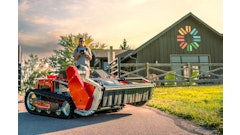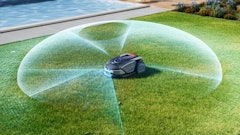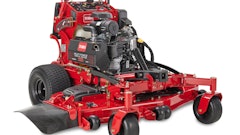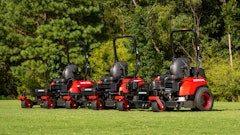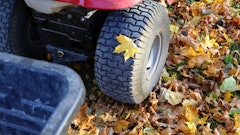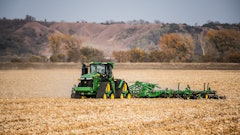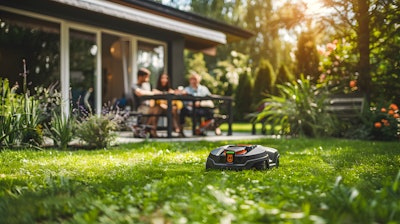
RTK stands for “real-time kinematics,” which is a technology that provides highly accurate positioning and navigation and helps correct GPS/GNSS signals.
“As GPS signals traverse different layers (ionosphere, troposphere, atmosphere) on their way from a satellite to a mower, they can get delayed,” says Matt Conte, corporate communications representative at Verizon. “This can add errors into the signal propagation time, which finally shows up as horizontal accuracy usually within a range of several meters.”
Conte adds that using a system of highly accurate base stations, RTK technology can bring location accuracy to as precise as 2 centimeters.
Diving deeper, Charles Brian Quinn (CBQ), co-founder and CEO of Greenzie, notes that just GPS technology uses three satellites to determine an exact location through trilateration, while RTK adds a fourth point, typically placed within about 50 kilometers of a site.
“What surveyors have been doing forever is they add a fourth point and come back later and run the kinematics, but they don’t do it in real time,” CBQ says. “The fun part is that real-time kinematics does it live.”
Benjamin Houssa, vice president for robotics at Echo, adds that the stationary nature of that fourth point helps ensure better localization.
“The fixed antenna knows exactly the position, and it's always sending the correction value to the robot,” Houssa says. “While the satellites are moving, there may be some imprecisions, and because we know precisely where the antenna is and the antenna is not moving, we can actually send a correction to the robot.”
Conte adds that localization is 10 to 100 times more accurate than GPS on a smartphone
“It’s important first step in the operation of an autonomous system,” Conte says. “Highly accurate location data serves as a baseline for onboard computers to determine where to direct an autonomous object next.”
Billy Otteman, marketing director at Scythe Robotics, adds that localization is especially important as the mowers navigate around obstacles and move closer to the edges of mow zones.
“With that technology, we have an exact understanding of where it is, compared to other solutions like a cellphone or desktop internet, where you’ve got a vague idea (within 60 to 80 centimeters of accuracy),” Otteman says. “Sixty to 80 centimeters is pretty different when you're talking about things like sidewalks or drainage ditches or other obstacles that might be in the way.”
If RTK technology didn’t exist, CBQ says robotic mowers would be less accurate.
“They would not be able to stay as straight, especially if you’re mowing in long rows,” CBQ says. “It may drive 5 feet off course.”
Additionally, RTK technology allows robotic mowers to be wire free.
“The adoption of robotics in the U.S. has been fairly slow, mainly because of the added need for the installation of the wire and maintenance to upkeep general wire breaks,” says Justin Novosel, executive vice president and general manager of Sunseeker. “RTK allows all of those headaches to be eliminated immediately.”
Houssa agrees that mowing technology that only relies on wires may be imperfect solutions because often the wire would be cut or damaged.
“Whether it’s vertical aeration, people working underground or a mouse going in and chewing the cable, the wires would get cut or damaged or even rotten,” Houssa says. “In the worst case, if you have lightning, that cable will act as a big antenna and bring all these disturbances to the system.”
What to know
When deploying mowers that use RTK, Otteman notes that line of sight to the sky is essential.
“When you’re under a tree canopy—and the dense areas in the Carolinas come to mind—or in areas between a lot of tall buildings, that might cut off the robot’s ability to connect with the satellites in the sky,” Otteman says.
While overcast days used to be an issue with RTK, Otteman says for the most part, those have been resolved.
If RTK technology fails, the experts say many mowers are equipped with other technologies to help it complete the job at hand.
“If one of our mowers loses RTK connectivity, the mower never stops because it always has a backup system to continue the path of cut and to continue the task at hand,” says Matt Moore, director of sales at Sunseeker.
Before installing a mower that uses RTK technology on a given site, Conte recommends asking the following questions:
· Does it require self-installation of a RTK station on-site?
· Can a base station be shipped directly to the customer site for immediate use?
In a similar vein, CBQ recommends checking that the area is covered.
“You can ask your provider and look at the coverage maps, like in the olden days when you used to look at coverage maps to see if you have cell service when you went on a trip,” CBQ says.
Otteman adds that Scythe checks the RTK coverage in that region and ensures the providers are covering the properties being maintained.
“We try to handle all of that behind the scenes before our customer even has to worry about it,” Otteman says. “It’s just about making sure in advance the RTK tower is set up regionally, and if not, we make sure it’s deployed before our customer gets the robots.”
Top tips
If a robot is having trouble connecting in the field despite being connected to an RTK network, Otteman says there are a few things operators can try.
For example, if robots are driven in an enclosed trailer for a considerable distance from one site to another, they may take a few extra minutes to connect at the second location. He recommends driving the robot forward 10 feet in a straight line.
“That momentum will help the GPS connection establish that locale.” Otteman says. “It's similar to Google Maps if you've ever had a hard time rerouting, like if you take a wrong turn, and it takes a few minutes for Google Map to reroute. It's doing the exact same thing.”
What’s ahead
Moving forward, Otteman says the technology will become more advanced and mowers will rely less on RTK technology.
“As the robot is able to see and navigate around the environment, it will be able to know using the cameras where it is and what obstacles to avoid,” Otteman says.
Finally, Moore adds that with the labor shortage, robotic mowers that use RTK technology can help ease that strain.
“These mowers are not replacing people because you still need qualified people to install and support them, but it really allows the landscapers to reappropriate the labor they have into other items, whether it's enhancements or higher-margin work,” Moore says.


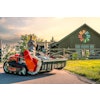


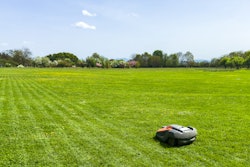


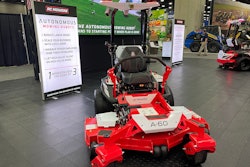
![Gravely Pro Turn Mach One My23 Dsc03139 Edit 1200x800 5b2df79[1]](https://img.greenindustrypros.com/mindful/acbm/workspaces/default/uploads/2025/10/gravely-pro-turn-mach-one-my23-dsc03139-edit-1200x800-5b2df791.BucBnDoN22.jpg?ar=16%3A9&auto=format%2Ccompress&fit=crop&h=135&q=70&w=240)

